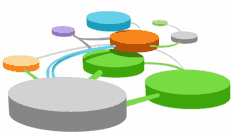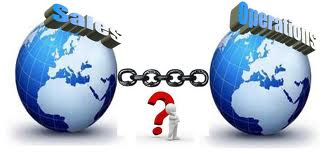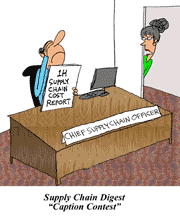|
 |
September 6, 2013 - Supply Chain Newsletter
|
|
|
|
FEATURED SPONSOR: KEWILL
|
 |
Logistics in 2020: The Future is Closer Than You Think

|
|
| |
 |
|
| |
Reader's Respond - Systems Thinking and the Supply Chain
Once again, maybe I should reconsider taking a few days off each year.
In the almost 10 years of Supply Chain Digest, writing something like 48 columns a year, I have only missed the call on 5-6 occasions, giving up the prestigious First Thoughts platform to a small group of guest commentators.
| GILMORE SAYS: |
"I learned a long time ago that some people can think at a system level, and some simply cannot. Hopefully, those rising up the supply chain ranks are capable of doing so, but I suspect that is not always the case."
WHAT DO YOU SAY?
Send us your
Feedback here
|
For each of the past three summers, one of those guests has been David Schneider, a former retail industry logistics executive among many other accomplishments, now running his own consulting firm. This year, I coaxed a two-part series out of him, on "systems thinking" - or more accurately, the lack thereof - in the supply chain. You'll find those column here: Systems Thinking Part 1 and Part 2.
Well I'll be darned if those columns didn't generate more reader feedback than I have had in any of my columns for quite a few months. While modestly upset with that fact, I am happy it has been enough that I can do a "Reader's Respond" column this week for the first time in awhile, presenting the highlights of the 20+ emails we received, making it an easy week on me.
So here we go.
John Mayo of GE was one of the first to respond, saying that "I think most companies use some form of systems thinking for supply chain systems. It is the degree to which they apply and use technology advances in their design that is the bigger issue."
I agree - but I believe that for reasons I will explain later that systems thinking is in fact often quite limited.
Mayo added "That said, many companies could improve the business and system processes within their four walls with a strategic view of how to improve the key drivers of the supply chain. From my own experience, it still seems likes there are too many hands in the pot, and not enough ‘intelligence’ in our systems."
Trevor Miles of supply chain software vendor Kinaxis sent in a great letter on the topic, in part saying that a downside to some systems thinking is that it created a belief that a full a supply chain system can actually be accurately modeled in software and optimization engines.
"There are so many nuances and competing objectives in a decision that change frequently that I do not believe we can write an objective function for an optimization that captures all the trade-offs that need to be performed," Miles said. "How does one translate customer service objectives, inventory levels, revenue, and margin into a common UOM against which we can run an optimization engine? And all that assuming we know all the variables with sufficient certainty that the optimum is meaningful. Well, we don’t."
That is a very interesting perspective that we will explore in more detail on these pages soon.
My good friend Gene Tyndall of Tompkins International as usual offered some supply chain insight on the topic with these comments:
|
| |
"Systems thinking, when applied to supply chains, addresses the four supply chain flows: physical, information, cash, and work," Tyndall observed. "Supply chain managers often lose sight of this fact - that supply chains are really about the efficiency and effectiveness of how these four flows perform. Every incremental change we make in any supply chain processes is only as important as its effects on one or more of these flows."
He added that "The "age of specialization" has been beneficial for the most part, but has help create siloed thinking when systems analysis was overlooked. We need to get back to a balance of both."
Schneider had a bit of a distribution center orientation in his pieces, and I completely agree his example of a clear lack of systems thinking in most operations is the DC receiving process. Watch the process for awhile, Schneider said. Does it look like it was optimally designed across shipper, carrier and receiving company? Hardly.
So, Chuck Crews of Fruit-of-the-Loom wrote us that "This [article] is excellent. Whether or not DC management (as an example group) utilizes system thinking or not can make or break a distribution facility. I've seen it as you have (both positive and negative)."
Along the same lines, Mark Fralick of GetUsROI has noted for years that distribution center excellence is in the end all about "flow," and to optimize total flow across a full facility obviously requires a full systems perspective - and supporting technology that can execute that vision.
However, Fralick notes there are some natural barriers to the systems thinking approach.
"The problem I see is that there is rarely one person who is responsible for all of this. You have elements of marketing forecasting, purchasing, transportation, distribution, etc., involved," Fralick notes. "In the real world one of the big reasons that people don't think this way is that there are a lot of fiefdoms in play and no one is sharing their time and effort to look at the big picture. If you get these various hats all in the same room together periodically and just communicate - that is the key."

Shelley Jordan of NobCessory agrees with Schneider and wrote that "I believe it is difficult for most to master the systems thinking approach and not just think and use causal diagrams, but implement solutions."
Causal diagrams are essential to effective systems thinking, Schneider said, and Jordan agreed, saying that "We are creating casual diagrams regularly and they change our decision making process."
Maybe you should be employing causal diagrams too.
Millard Humphreys of QED Logistics says that like Schneider he has used a systems thinking approach with success for years.
"The causal diagram and some of the Lean-Six Sigma tools are indeed keys to implementing systems thinking," Humphreys said. "Two additional requirements are that an individual be prepared to perform a thorough analysis without leaping quickly to what may be erroneous conclusions, and second that the individual/team have full understanding of the process, including those areas directly impacted and those only tangentially related."
He added that "It is this latter requirement that makes systems thinking a particularly suitable tool for supply chain processes, as supply chain impacts most if not all of the various functions and silos within an organization."
There were a number of more emails, but unfortunately we are about out of space. We'll publish the rest in our Feedback section below over the next couple of weeks.
My own view: I learned a long time ago that some people can think at a system level, and some simply cannot. Hopefully, those rising up the supply chain ranks are capable of doing so, but I suspect that is not always the case.
That said, a systems approach almost by definition has a cross-functional impact. That makes it hard - and is why so many decisions and processes are in fact relegated to silos.
It takes very strong supply chain leadership to break through those silos and consistently adopt a systems approach. If that leadership is missing, systems thinking will nevertheless come eventually as part of a supply chain transformation -usually with a new head of supply chain in charge of the effort.
Any reaction to these reader comments on systems thinking? We would love some more. Let us know your thoughts at the Feedback section below.
|
| |
|
| |
|
|
|
New Videocast: |
Crate and Barrel's Holistic Supply Chain and the Role of Supply Chain Visibility
|
 |
Explore how the import and export operations enabled the business strategy of Crate and Barrel while focusing on cost savings. Discover the outside influences that continue to drive Crate and Barrel's synergistic team and approach, as well as hear how these same driving factors establish the requirements for supply chain visibility.
Featuring Virginia Thompson, Senior Director of Import/Export at Crate and Barrel and Stephanie Miles, Senior Vice President of Commercial Services at Amber Road
|
 |
| Tuesday, September 24, 2013 |
|
On Demand Videocast: |
Building S&OP Shock Absorbers for your Business
|
 |
Increasing S&OP Speed, Visibility and Control for Improved Decision-Making. Radisys worked with Steelwedge and icon-scm to deal with everything from manufacturing outsourcing and global volatility to mergers and acquisitions-and to ensure that the S&OP goals remained in line with overall business objectives.
Featuring Lisa Aleman, Director, Sales and Operations Planning and Control at Radisys
|
 |
| Now Available On Demand |
|
On Demand Videocast: |
What is the State of JDA eight?
|
 |
An Integrated Suite of More than 30 Supply Chain Planning and Execution Solutions, All Delivered in the Cloud. JDA Says it is an Industry "Game Changer." Is that Right? SCDigest editor Dan Gilmore Interviews a JDA Exec and Execs from HEB and Coca-Cola Bottling Co. Consolidated to Get the Answers.
Featuring Danny Halim, Vice President, Manufacturing Industry Strategy at JDA, Charles Devenney, Director, Supply Chain Planning, Coca-Cola Bottling Co. Consolidated, Ron Ozment, Director, Supply Chain Strategy, H-E-B
|
 |
| Now Available On Demand |
|
|
YOUR FEEDBACK
We received quite a bit of Feedback on guest columnist David Schneider's two-part series on Systems Thinking in the Supply Chain - or lack thereof. So much so we might have enough for a "Reader's Respond" column in a couple of weeks.
We publish a few of those letters here this week.
|
Feedback of the Week - On Systems Thinking in the Supply Chain
 |
I think most companies use some form of systems thinking for supply chain systems. It is the degree to which they apply and use technology advances in their design that is the bigger issue.
Secondly, this design is confounded by competing and opposing stakeholders such as the Carriers who control some of the software we use and the tendency of companies not to extend business processes beyond their system borders. Finally, federal governments are stakeholders, who sometimes still impose paper-based systems, which constrain system thinking.
That is not to say that many companies could improve the business and system processes within their four walls with a strategic view of how to improve the key drivers of the supply chain. From my own experience, it still seems likes there are too many hands in the pot, and not enough 'intelligence' in our systems.
The causal diagram in my humble opinion is too abstract and is not as useful as a good fishbone diagram supported by swim-lane diagrams which can be used in a business process or systems process.
context.
John Mayo
WMS ECLIPS (MOVE) Project Leader
GE
|
 |
| |
More Feedback on Systems Thinking |
|
| |
|
|
 |
This is a great piece, and a topic really important to pursue. We, as SCM practitioners, continue to perpetuate processes and technologies that were devised in the 1960s before the advent of the PC and Excel, let alone the internet and in-memory computing. All the solutions devised and developed in the 1990s were designed to satisfy this model and they continue to perpetuate this approach by focusing on functional needs with little attention given to the horizontal end-to-end process needs.
Even though we, Kinaxis, focus more on planning and less on execution, your examples are the type of issue we try to get our customers to understand and address.
I have moved on - I hesitate to use the word 'progressed' because it implies a maturity curve - from Systems Thinking to Complexity. It seems to have a richer context and is less 'mechanical' or mathematical. I say this because I believe in GEP Box' assertion that "Every model is wrong, but some are useful."
Complexity helps you understand what you don't know or assume, and therefore the limitations of your model. Systems Thinking tends to assume that if only you included a few model variables and a better understanding of how things interrelate you will build the perfect model.
I used to fall into this group having studied Chem Eng at Undergrad and Masters level. But then I started a PhD in IE and OR focusing on decision under uncertainty at Penn State in the 1980s, only to be confronted by things like Queuing Theory that knocked my feet out from under me. I eventually decided that the uncertainty of life was more interesting but it was the realization that even a small amount of uncertainty in the input variables have a the impact on the confidence interval of the optimum that made me give up my research. And then I ended up working for i2 and having many conversations about the use of optimization in SCM.
There are so many nuances and competing objectives in a decision that change frequently that I do not believe we can write an objective function for an optimization that captures all the trade-offs that need to be performed. How does one translate customer service objectives, inventory levels, revenue, and margin into a common UOM against which we can run an optimization engine? And that assuming we know all the variables with sufficient certainty that the optimum is meaningful. Well, we don't.
Thanks again from bring up this topic. The sooner we get to this level of thinking the better.
Trevor Miles
VP, Thought Leadership
Kinaxis
|
 |
| |
|
|
 |
By the way, Prof. Jay Forrester, the creator of Systems Thinking (ST) and System Dynamics (SD), back in 1956, at MIT Sloan School of Management, discovered the bullwhip effect in operations and supply chains by using ST. This finding, among other important stuff, is in his first book, "Industrial Dynamics" - 1961, still a masterpiece in operations management.
Augusto Carreira
|
 |
| |
|
|
|
SUPPLY CHAIN TRIVIA ANSWER
Q: When Jim McNerney left GE to become CEO of 3M in the early 2000s, one of his first steps was to train hundreds of the company's top executives in what?
A: Lean-Six Sigma. McNerney taught one full day session personally. He is now CEO of Boeing. |
© SupplyChainDigest™ 2003-2013. All Rights Reserved.
SupplyChainDigest
PO Box 714
Springboro, Ohio 45066 |
|
|














